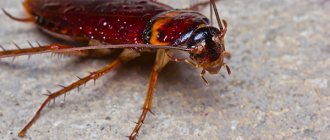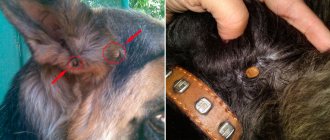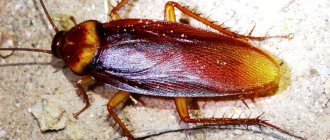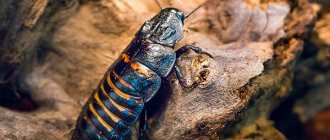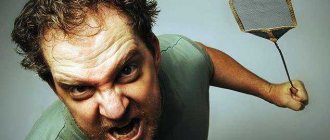At night, cockroaches can scatter throughout the apartment in search of food. Some of the pests can move around a sleeping person in search of exfoliated epidermis. While searching for a secluded place, they can crawl into the ear.
The following information will help you understand what to do if such an incident happens to one of your family members.
- 7.1 If various parts of the cockroach’s body remain in the ear
Can a cockroach get into the ear of a sleeping person?
You shouldn’t even think about whether a cockroach can get into your ear, since this insect is capable of getting into even the narrowest crevices, and the human hearing organ is just an “avenue” for it. Moreover, such cases have already been officially registered, although they are rare.
The ear canal in adults has a diameter of about 1 cm. This is quite enough for a cockroach, in search of a secluded place, to crawl inside. Children are also not protected from this situation, although their ear canals are smaller.
Cockroach
Harm from cockroaches
In principle, everything that was said is theoretically possible.
And even to the question of whether a cockroach can crawl into the ear of a sleeping person, one has to answer “yes.” It’s extremely rare, but it still happens. In addition, cockroaches are omnivores. This means that they will claim all your food supplies that they can get their hands on. Unfortunately, it will not be possible to share a meal with these “smaller brothers,” since these insects are carriers of various harmful microorganisms that can sometimes cause dysentery or typhoid fever. Therefore, the captured “war booty” will certainly have to be handed over to the red-haired occupiers. If you allow the colony to multiply and the insect population increases, then leather goods, plants, paper products (wallpaper, books, etc.) and even household appliances may suffer (cockroaches can chew wires and damage microcircuits). In the end, cockroaches are simply unpleasant, disgusting creatures that are terribly disgusting to most people and their very appearance can cause hysterics in the faint of heart and impressionable people. However, the appearance of these creatures cannot be blamed on them, since they did not choose it. But the most unpleasant and truly disgusting thing that can happen is when some curious cockroach tries to crawl into a person’s ear or nose. And besides the fact that this is unpleasant purely morally, it also causes quite serious physical discomfort.
What happens if a cockroach gets into your ear?
Typically this event occurs at night, when cockroaches (and many other types of insects) are active. The person immediately wakes up due to ear pain and noise: trying to find a way out of the trap, the insect will try to penetrate further. His mustache, hard wings and shell will irritate his delicate skin. Sometimes such an action of an insect, in addition to irritation, can cause slight bleeding.
The first desire is to remove the insolent one. Sometimes, when a cockroach crawls into the ear shallowly, this is possible, otherwise you will need the help of a specialist.
Do cockroaches bite?
The short answer is yes, cockroaches bite people. But do not rush to panic, because these insects are not at all aggressive, do not parasitize people and, in principle, are not inclined to attack anyone. On the contrary, at the first danger they run as fast as they can to the nearest shelter. Cockroaches bite humans quite rarely, and they do this not out of love for human flesh, but simply because of their food indiscriminateness.
No matter how scary cockroaches may seem, they will not eat a person alive, although I understand that such a consolation is unlikely to reassure those suffering from insectophobia. We also note that if a person is bitten by a cockroach, there is no risk of blood-borne infections, since these insects are not blood-sucking. However, this does not mean that living in a house with cockroaches is safe.
Find out more: How dangerous are domestic cockroaches for humans?
Why do cockroaches bite people?
To understand why cockroaches bite, let’s first find out what they eat. The diet of cockroaches is varied, it includes not only all kinds of human food products, but also waste, sewage, microparticles of the epidermis and even hair - any organic matter goes into food. When a person falls asleep, he no longer poses a danger to cockroaches, and is perceived by them simply as a biological object, and therefore a potential source of food.
In addition, cockroaches are moisture-loving and constantly need water, without which they can live no more than a week. And on the human body, for example, in the corners of the lips or eyes, insects can find much-needed life-giving moisture.
But, as mentioned above, cockroaches do not at all crave human flesh, but on the contrary, they are afraid of people and try to stay away. As a rule, these nocturnal creatures live in an apartment within the kitchen and bathroom, where they find sufficient food and water, and do not try to get into the bedroom. But as the population multiplies, the overcrowding gradually forces cockroaches to move around the house in search of new food sources. In neglected apartments, the risk of night bites and a cockroach crawling into the ear or nose of one of the residents increases.
What cockroaches bite?
For those who are wondering whether black or red cockroaches bite, we answer: by and large, it does not depend on the species; both can bite a person equally. Another thing is that red cockroaches are the most common species of this order on earth, and they are found in houses more often than others, and therefore red cockroaches bite people more often. In addition, black cockroaches are more cautious by nature, and I have not yet heard of a single case of a black cockroach getting into bed at night, although, of course, this is not excluded.
Other species are also common in subtropical and tropical latitudes, for example, American and Australian cockroaches; they also bite, like their red and black relatives.
How cockroaches bite
The cockroach has a gnawing mouthpart, which has no teeth or a sharp proboscis, but if the cockroach were the size of a person, the sight of its mouth would undoubtedly cause fear. But this is for horror movie plots, in reality cockroaches are tiny creatures compared to humans, and the way they bite is more like pinching. Although cockroaches' bite force is reported to be 50 times their own body weight, human skin is too thick for them to bite through.
To understand the mechanics of how cockroaches bite, imagine what elements the oral apparatus of these insects consists of:
- Labrum - the so-called upper lip, which covers other parts of the oral organ
- Mandibles (or mandibles) - hard cutting upper jaws with which cockroaches bite off pieces of food
- Maskilla - lower jaws (not as massive as mandibles) that help the cockroach hold food, and are equipped with segmented sensory palps for sensing taste
- Labium - the lower lip that closes the cockroach's mouth from below
- The hypopharynx is an enlarged subpharyngeal structure equipped with salivary glands for the secretion of saliva.
Cockroaches bite humans using their mandibles—an instrument that resembles pincers rather than jaws with rows of sharp teeth—and the most they can do is pinch. In this case, the cockroach, of course, does not tear off pieces of skin, but only pieces of the epidermis. At the moment of the bite, a pinch is felt for a split second, and the larger the type of cockroach, the more sensitive the bite.
This is what one woman said, who, due to the extremely high degree of infestation at home, had to experience the bites of red cockroaches:
“It feels like a mosquito or flea bite. You feel that someone is biting, for example, your leg - you look, and there is a cockroach sitting there. Moreover, I was bitten more often by small cockroaches (nymphs – approx.) than by large ones.”
Irina, Novorossiysk
Symptoms of an insect getting into the ear
Signs of a cockroach in the ear are as follows:
- Strong pain. At first it will be felt only in the auricle, and then spread to the temporal region. After a short time, the pain will become aching, but will be felt quite strongly.
- In the case when the cockroach crawls deep into the ear, up to the eardrum, the victim will hear a noise in the ear, and his hearing may also deteriorate.
- Due to the movements of the insect in the ear, the victim may panic. Particularly sensitive individuals and children sometimes experience psychological shock.
- Poor functioning of the vestibular apparatus can lead to disturbances in spatial orientation.
- If the victim has pathologies of the nervous system, he may involuntarily contract muscle groups or individual muscles.
- A painful sensation may appear in the epigastric region.
- Vomit.
What does a cockroach bite look like on a person - photo and description
Cockroaches usually bite people on parts of the body that have dead skin or food debris, as well as on moist areas of the face. If there is no other food nearby, these parts of a sleeping person's body will provide cockroaches with food and water:
- Fingers
- Nails
- Eyelashes
- Hands
- Feet
- Nose
- Mouth
When the population in an apartment becomes overly proliferated, cockroaches begin to make nests even in sofas and beds, and then a person turns into their closest source of food. In such circumstances, cockroach attacks become more frequent, as evidenced by multiple bite marks on the body.
Hard gnawing on the mandibles leaves tiny but noticeable wounds. This is what cockroach bites look like – photo on human skin:
If cockroaches regularly chew cuticles and fingernails at night, as well as the contour of the lips of children or adults, then characteristic signs of gnawing appear in these places.
Although cockroaches, unlike blood-sucking bugs, do not inject painkillers and other auxiliary components when biting, nevertheless, the saliva of these insects causes an allergic reaction on the skin in some people. Externally, cockroach bites are difficult to distinguish from the bites of other insects; allergy symptoms, as a rule, appear the same:
- Redness
- Short period of pain
- Inflammation and swelling
Depending on the organism, allergies can also manifest themselves in the form of mild swelling in the areas of cockroach bites, for example, on the eyelid if the cockroach nibbled the eyelash area at night.
Cockroach bites on humans - how to treat them
Cockroach bites, in addition to allergies, rarely threaten any serious consequences. Much more dangerous are intestinal infections carried by these pests, which enter the body through contaminated food and utensils. True, if a cockroach bite occurs in the area of an open wound, this carries the risk of bacterial infections that require medical intervention.
If only redness and swelling remain on the body after the bites, then simply wash the damaged area generously with warm water and antibacterial soap and pat dry with a paper towel. It also won't hurt if you wipe the bite area with an alcohol wipe or hydrogen peroxide. To relieve symptoms of skin allergies, use fenistil gel or similar products; in case of an acute allergic reaction, consult a doctor.
Find out more: How long do cockroaches live and how long can they go without food and water?
What can it be confused with?
The signs listed above may not always mean that an insect has entered the ear. Sometimes these may be symptoms of certain problems or diseases:
- otitis media or inner ear;
- formation of sulfur plugs;
- a foreign inorganic object that has entered the ear.
Ear plug
An ordinary person without medical education, much less a child, will not be able to independently identify the cause of pain and make a diagnosis. Only a doctor after an examination can identify the problem.
Cockroach in a child's ear
The symptoms of a cockroach entering a child’s ear are the same as in adults – severe painful discomfort. The child begins to be capricious, scratch his ear, and complain of pain. The smaller the child, the more difficult it is to determine the cause of the pain, especially in cases where the cockroach is small, has crawled deep into the ear and is not visually visible.
It is very difficult to independently remove an insect from a child’s ear: the ear canal is small, and it is impossible to do this safely without special tools and knowledge.
Attention! If children show symptoms that an insect has entered their ear, they should immediately consult a doctor or emergency room. To prevent the insect from causing discomfort to the child, it is necessary to introduce a few drops of petroleum jelly into the ear canal.
When only a doctor can help
When a cockroach has crawled too deep into the ear, then at home you can only try to kill the insect, and a doctor must remove the dead body. In addition, you should definitely contact an otolaryngologist if, after removing the parasite, it is missing some body fragments.
If the cockroach has penetrated in such a way that the membrane separating the outer and middle ear has been affected, then it is necessary not only to get rid of the parasite, but also to restore auditory functions.
Doing this yourself at home is unrealistic. The doctor must select appropriate therapeutic methods.
Therapeutic procedures will help improve blood circulation and also restore the tone of the ear muscle fibers.
Often, after removing an insect, victims are prescribed the following procedures:
- blowing the ear canal to normalize ventilation;
- washing the auricle with antiseptic solutions;
- massage designed to restore hearing;
- laser therapy to normalize blood circulation and the reaction of nerve fibers.
But most often the cockroach is removed from the ear quite quickly. It does not have time to cause harm and there is no need for drug treatment.
Medical diagnosis
The vast majority of foreign bodies in the ear are not true medical emergencies. But insects, as potentially harmful foreign objects in the ear, should be removed immediately due to the possibility of infection. Insects must be removed quickly as they cause unpleasant symptoms and severe discomfort and may sting or bite, causing further damage. A few drops of mineral oil can be placed in the ear canal before going to the doctor to kill the insect and stop the buzzing or scratching sensation on the eardrum.
How to get a cockroach out of your ear?
First of all, you need to immediately contact an otolaryngologist. A specialist will use a syringe to remove the insect. To do this, water is drawn into a syringe and delivered into the ear under a certain pressure. If this method does not help, the doctor will remove the cockroach with a special tool.
This usually takes about 15 minutes, but if the cockroach has to be removed in parts due to a violation of its integrity, it may take much more time.
Important! It is unacceptable to remove the pest yourself - if it has crawled deep, you can damage the ear canal and eardrum.
But what to do in cases where a cockroach has crawled into your ear, and there is no way to seek help? There are several techniques that can be used to remove an insect from your ear:
- Lay the victim down so that he is comfortable.
- Place a few drops of baby or vegetable oil into the ear canal. This will help kill the pest very quickly. You cannot use water instead of oil - an insect can live in water for quite a long time, about 40 minutes, while it will flounder and try to get out, causing pain to the victim.
- After 15-20 minutes, rinse your ear with warm water. The cockroach is washed out. It is necessary to immediately check whether everything is in place - head, legs, wings.
Why should you see a doctor?
If a cockroach gets into your ear and you manage to remove it, you still need to see a doctor. Especially if such trouble happened to a child. The help of a specialist will also be needed for an adult from whom the insect was only partially removed.
Visit doctor
On a note ! A cockroach's head, separated from its body, can remain alive for several hours. Being in the ear, it can bite.
The importance of qualified help
If a cockroach crawls into your ear, it is best to take advantage of this if you have the opportunity to see a doctor. Sometimes unqualified help from a friend, acquaintance, relative, or any other person who is nearby can cause serious consequences. So, without special tools and knowledge, when helping another, you can damage his ear canal or even his eardrum.
Also, damage caused by the hard shell and legs of the insect may remain in the ear. If they are not treated, an inflammatory process may begin.
The danger of cockroaches in the ear
Many people believe that the insect reaches the brain through the ear canal. This is not true. The human ear has a special structure, so barbels do not penetrate beyond certain limits.
As soon as the pest gets into a tight space in which it is difficult for him to move, he makes attempts to get out. At the same time, it comes into contact with soft tissues and the eardrum. Every movement is accompanied by pain. With their sharp wings, males damage soft tissues. This leads to bleeding.
Another difficulty lies in the fact that the pest cannot get out of the trap on its own. To get it, you need to perform certain actions.
This problem is encountered much less frequently by those people who carry out preventive measures:
- Clean your apartment or house from insect pests. To do this, chemicals and folk remedies are used.
- If you need to spend the night in a tent, cover your ears with a hat or bandage. It is also possible to use products that repel pests.
How to get a cockroach out yourself?
How to get a cockroach out of your ear if no one is nearby? The main thing is not to scream or panic, but to slowly drip vegetable oil into your ear using, for example, a pipette. After 10 minutes, tilt your head so that the oil flows out on its own. In half the cases, this is enough for the insect to come out of the ear.
It is unacceptable to use the following to extract an insect:
- cotton buds;
- tweezers;
- matches, etc.
Various similar items are not only useless in this case, but can also introduce infection into the ear canal.
Important! It is difficult to remove an insect from your ear on your own, so you should not hesitate, you must immediately go to the hospital.
If various parts of the cockroach's body remain in the ear
The insect fragments remaining in the ear can not only cause discomfort and itching, but also cause inflammation, abscesses, and other complications, so they must be removed. Only a doctor should and can do this.
The importance of qualified help
A specialist will be able to accurately determine the cause of painful symptoms and be able to pull a cockroach out of the ear with minimal negative consequences. If you consult a doctor in a timely manner, you can avoid inflammation of the eardrum and get away with minor damage. In such a situation, antiseptic, anti-inflammatory drops, and local antibiotics are prescribed. The condition returns to normal within a few days.
When trying to remove a cockroach from your home, the likelihood of a ruptured eardrum, infection, hearing loss or hearing loss increases. The pest is washed out with water under pressure, which is put into the ear using a syringe. If the event does not give the desired result, the insect is pulled out piece by piece with a scalpel, knitting needle, or other medical instruments. The insect cannot climb further than the eardrum, so the main task is to remove the parasite completely from the eardrum, either in one piece or in parts.
After a successful operation, antibacterial and anti-inflammatory drops are prescribed for 5 days. If the eardrum is significantly damaged, complex therapy is prescribed, carried out under the strict supervision of specialists.
How to avoid such cases
Any insect can get into the ear not only at home, but also in a three-star hotel, on an overnight camping trip, etc. The following methods will help prevent this from happening:
- Use earplugs.
- Wear a hat at night.
- Sew special headphones from thin fabric that will protect your ears and at the same time not interfere with the penetration of sounds.
- Use pest repellents (while camping in nature).
- Fight cockroaches in the house - set traps, use all possible means.
Prevention measures
In order to avoid such problems, you need to fight against domestic insects and prevent them from becoming widespread in the apartment. Small children need to wear thick hats at night to protect their ears. For adults, earplugs or simple pieces of cotton wool in their ears will help.
When hiking, it is necessary to ensure that the tent is airtight. Along the perimeter you can lay out aromatic herbs that cockroaches, ants, and other insects cannot tolerate, for example, tansy (fresh or dry).
No need to eat in a tent. Teach children that this is a place to rest at night. If there is no food, the insects will not come.
The main method of prevention remains getting rid of cockroaches. There are many ways to say goodbye to these domestic parasites forever. They are not only unpleasant to look at, but are carriers of dangerous diseases - tetanus, dysentery, lichen, salmonellosis, urogenital viruses.

